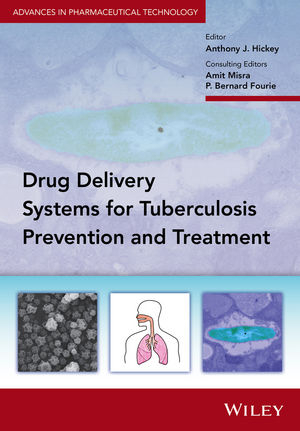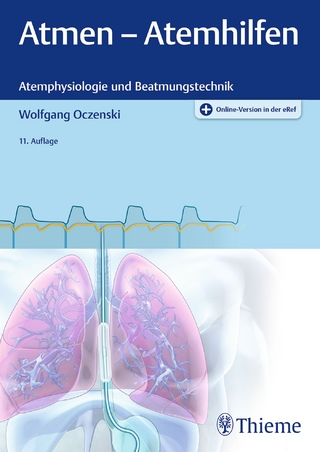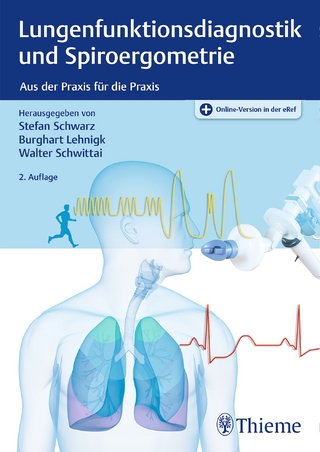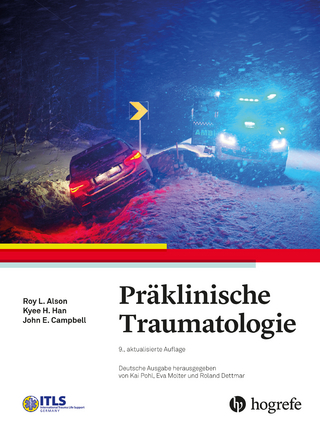
Delivery Systems for Tuberculosis Prevention and Treatment
John Wiley & Sons Inc (Verlag)
978-1-118-94317-5 (ISBN)
- Titel z.Zt. nicht lieferbar
- Versandkostenfrei innerhalb Deutschlands
- Auch auf Rechnung
- Verfügbarkeit in der Filiale vor Ort prüfen
- Artikel merken
Presents a novel perspective on tuberculosis prevention and treatment
Considers the nature of disease, immunological responses, vaccine and drug delivery, disposition and response
Multidisciplinary appeal, with contributions from microbiology, immunology, molecular biology, pharmaceutics, pharmacokinetics, chemical and mechanical engineering
Anthony J. Hickey, Distinguished Fellow (appointed June 2012), is a Program Director in Inhaled Therapeutics in the Center for Aerosol and Nanomaterials Engineering at the Research Triangle Institute, North Carolina, USA. Dr Hickey has more than 30 years of academic and research experience in pulmonary biology, aerosol physics, powder dynamics, pharmacokinetics and drug disposition, formulation design, and device development. Since joining RTI in 2011, he has conducted research related to pulmonary drug and vaccine delivery for tuberculosis treatment and therapy. Additionally, Dr. Hickey is an adjunct professor of biomedical engineering at the University of North Carolina at Chapel Hill School of Medicine, emeritus professor of molecular pharmaceutics at the University of North Carolina at Chapel Hill Eshelman School of Pharmacy, and founder and president of Cirrus Pharmaceuticals, Inc.
List of Contributors xvi
Foreword xviii
Series Preface xxi
Preface xxiii
1 Introduction: A Guide to Treatment and Prevention of Tuberculosis Based on Principles of Dosage Form Design and Delivery 1
A.J. Hickey
1.1 Background 1
1.2 Dosage Form Classification 3
1.3 Controlled and Targeted Delivery 5
1.4 Physiological and Disease Considerations 6
1.5 Therapeutic Considerations 7
1.6 Conclusion 8
References 8
Section 1 Pathogen and Host 11
2 Host Pathogen Biology for Airborne Mycobacterium tuberculosis: Cellular and Molecular Events in the Lung 13
Eusondia Arnett, Nitya Krishnan, Brian D. Robertson and Larry S. Schlesinger
2.1 Introduction 13
2.2 Lung 14
2.3 General Aspects of Mucus and Surfactant 17
2.4 General M. tuberculosis 18
2.5 M. tuberculosis Interaction with the Lung Macrophage 19
2.6 M. tuberculosis Interaction with other Respiratory Immune Cells 23
2.7 TB Granuloma 29
2.8 Conclusion 30
References 30
3 Animal Models of Tuberculosis 48
David N. McMurray
3.1 Introduction 48
3.2 What is an Animal Model of TB? 49
3.3 How are Animal Models of TB Used? 50
3.4 TB Animal Models Currently Used for TB Drug and Vaccine Evaluation 51
3.5 Summary 58
References 59
Section 2 Immunological Intervention 67
4 Vaccine Preparation: Past, Present, and Future 69
Dominique N. Price, Nitesh K. Kunda, Amber A. McBride and Pavan Muttil
4.1 Introduction 69
4.2 Early Efforts in TB Vaccine Development 71
4.3 Current BCG Vaccine Formulation 73
4.4 Novel TB Vaccination Strategies 76
4.5 Future Perspective 84
4.6 Conclusions 85
References 85
5 TB Vaccine Assessment 91
Andre G. Loxton, Mary K. Hondalus and Samantha L. Sampson
5.1 Introduction 91
5.2 Preclinical Vaccine Assessment 92
5.3 Clinical Assessment of Vaccines 97
5.4 Laboratory Immunological Analysis and Assessment of Vaccine Trials 102
5.5 How well do the Available Preclinical Models Predict Vaccine Success in Humans? 103
References 105
Section 3 Drug Treatment 111
6 Testing Inhaled Drug Therapies for Treating Tuberculosis 113
Ellen F. Young, Anthony J. Hickey and Miriam Braunstein
6.1 Introduction 113
6.2 The Need for New Drug Treatments for Tuberculosis 114
6.3 Inhaled Drug Therapy for Tuberculosis 114
6.4 Published Studies of Inhalation Therapy for TB 115
6.5 The Guinea Pig Model for Testing Inhaled Therapies for TB 116
6.6 Guinea Pig Study Design 117
6.7 Purchase and Grouping Animals 118
6.8 Infecting Guinea Pigs with Virulent Mycobacterium tuberculosis 118
6.9 Dosing Groups of Guinea Pigs with TB Drugs 119
6.10 Collecting Data 121
6.11 Aerosol Dosing Chambers and Practice 122
6.12 Nebulizer Aerosol Delivery Systems for Liquids 123
6.13 Dry-Powder Aerosol Delivery Systems for Solids 125
6.14 Summary 127
Acknowledgements 127
References 127
7 Preclinical Pharmacokinetics of Antitubercular Drugs 131
Mariam Ibrahim and Lucila Garcia-Contreras
7.1 Introduction 131
7.2 Factors Influencing the Pharmacokinetic Behavior of Drugs 132
7.3 Pulmonary Delivery of Anti-TB Drugs 138
7.4 Pharmacokinetic Study Design 140
7.5 Implications of PK Parameters on Efficacy 144
7.6 Case Studies (Drugs Administered by Conventional and Pulmonary Routes) 146
References 152
8 Drug Particle Manufacture – Supercritical Fluid, High-Pressure Homogenization 156
Kimiko Makino and Hiroshi Terada
8.1 Introduction 156
8.2 Preparation of Nano- and Micro-particles 157
References 159
9 Spray Drying Strategies to Stop Tuberculosis 161
Jennifer Wong, Maurizio Ricci and Hak-Kim Chan
9.1 Introduction 161
9.2 Overview of Spray Drying 162
9.3 Advances in Spray Drying Technology 174
9.4 Anti-Tuberculosis Therapeutics Produced by Spray Drying 179
9.5 Conclusion 187
9.6 Acknowledgements 187
References 187
10 Formulation Strategies for Antitubercular Drugs by Inhalation 197
Francesca Buttini and Gaia Colombo
10.1 Introduction 197
10.2 Lung Delivery of TB Drugs 198
10.3 Powders for Inhalation and Liquids for Nebulization 200
10.4 Antibacterial Powders for Inhalation: Manufacturing of Respirable Microparticles 202
10.5 Antibacterial Powders for Inhalation: Devices and Delivery Strategies 208
10.6 Conclusions and Perspectives 211
References 211
11 Inhaled Drug Combinations 213
Sanketkumar Pandya, Anuradha Gupta, Rajeev Ranjan, Madhur Sachan, Atul Kumar Agrawal and Amit Misra
11.1 Introduction 213
11.2 Standard Combinations in Oral and Parenteral Regimens 214
11.3 The Rationale for Inhaled Therapies of TB 216
11.4 Combinations of Anti-TB Drugs with Other Agents 222
11.5 Formulation of Inhaled Drug Combinations 224
11.6 Conclusions 230
References 230
12 Ion Pairing for Controlling Drug Delivery 239
Stefano Giovagnoli, Aurélie Schoubben and Carlo Rossi
12.1 Introduction 239
12.2 Ion Pairing Definitions and Concepts 240
12.3 Ion Pairs, Complexes and Drug Delivery 245
12.4 Remarks 252
References 254
13 Understanding the Respiratory Delivery of High Dose Anti-Tubercular Drugs 258
Shyamal C. Das and Peter J. Stewart
13.1 Introduction 258
13.2 Tuberculosis 259
13.3 Drugs Used to Treat Tuberculosis, Doses, Challenges and Requirements for Therapy in Lungs 260
13.4 Approaches for Respiratory Delivery of Drugs 262
13.5 Current DPI Formulations and Their Mechanisms of Aerosolization 262
13.6 DPI Formulations for Tuberculosis and Requirements 264
13.7 Issues to Consider in Respiratory Delivery of Powders for Tuberculosis 264
13.8 Relationship between De-agglomeration and Tensile Strength 266
13.9 Strategies to Improve De-agglomeration 268
13.10 DPI Formulations having High Aerosolization 269
13.11 Devices for High Dose Delivery 270
13.12 Future Considerations 271
References 272
Section 4 Alternative Approaches 275
14 Respirable Bacteriophage Aerosols for the Prevention and Treatment of Tuberculosis 277
Graham F. Hatfull and Reinhard Vehring
14.1 Introduction 277
14.2 Treatment or Prevention of Tuberculosis Using Phage-based Agents 282
14.3 Selection of Mycobacteriophages 284
14.4 Respiratory Drug Delivery of Phages 285
14.5 Summary and Outlook 288
Acknowledgements 288
References 288
15 RNA Nanoparticles as Potential Vaccines 293
Robert DeLong
15.1 Introduction 293
15.2 Nanoparticles 293
15.3 RNA Nanoparticle Vaccines 294
15.4 Progression of Nanomedicines into the Clinic 295
15.5 The Stability Problem 295
15.6 The Delivery Problem 298
15.7 RNA as Targeting Agent or Adjuvant? 298
15.8 Challenges for RNA Nanoparticle Vaccine Characterization 300
15.9 On the Horizon 301
References 301
16 Local Pulmonary Host-Directed Therapies for Tuberculosis via Aerosol Delivery 307
Mercedes Gonzalez-Juarrero
16.1 Introduction 307
16.2 Lung Immunity to Pulmonary M. tuberculosis Infection 309
16.3 Host-Directed Therapies 313
16.4 Limitations of Preclinical Studies to Develop Inhalational Host-Directed Therapies for Tuberculosis 317
16.5 Preclinical Testing of Inhaled Small Interference RNA as Host-Directed Therapies for Tuberculosis 318
Acknowledgements 319
References 319
Section 5 Future Opportunities 325
17 Treatments for Mycobacterial Persistence and Biofilm Growth 327
David L. Hava and Jean C. Sung
17.1 Introduction 327
17.2 Mycobacterial Persistence and Drug Tolerance 328
17.3 Mycobacterial Multicellular Growth 329
17.4 Mycobacterial Lipids Involved in Biofilm Formation 330
17.5 Therapies to Treat Mycobacterial Biofilms and Persistence 332
17.6 Conclusion 339
References 339
18 Directed Intervention and Immunomodulation against Pulmonary Tuberculosis 346
Dominique N. Price and Pavan Muttil
18.1 Introduction 346
18.2 TB Immunology 347
18.3 Animal Models of Immunotherapies and Vaccines for TB 351
18.4 The Current TB Vaccine – Bacille Calmette Guérin 353
18.5 Other Vaccines Platforms 357
18.6 Pulmonary Immunization 361
18.7 Immunotherapeutic Agents against TB 364
18.8 Conclusion 367
References 367
Section 6 Clinical Perspective 379
19 Clinical and Public Health Perspectives 381
Ruvandhi R. Nathavitharana and Edward A. Nardell
19.1 Introduction 381
19.2 Background 382
19.3 Clinical Considerations 382
19.4 Public Health Considerations 385
19.5 Inhaled Drugs and Other Alternative Delivery Systems 387
19.6 Clinical Trials of Inhaled Injectable Drugs 388
19.7 Other Novel Delivery Strategies 393
19.8 Pediatric Delivery Systems 393
19.9 Conclusion 394
References 394
20 Concluding Remarks: Prospects and Challenges for Advancing New Drug and Vaccine Delivery Systems into Clinical Application 400
P. Bernard Fourie and Richard Hafner
20.1 Introduction 400
20.2 Progress in the Formulation and Manufacturing of Drugs and Vaccines for Tuberculosis 401
20.3 Considerations in the Development of TB Drug and Vaccine Delivery Options 404
20.4 Concluding Remarks 410
References 411
Index 415
| Erscheinungsdatum | 15.11.2016 |
|---|---|
| Reihe/Serie | Advances in Pharmaceutical Technology |
| Mitarbeit |
Berater: Amit Misra, P. Bernard Fourie |
| Verlagsort | New York |
| Sprache | englisch |
| Maße | 175 x 246 mm |
| Gewicht | 816 g |
| Themenwelt | Medizinische Fachgebiete ► Innere Medizin ► Pneumologie |
| Studium ► Querschnittsbereiche ► Infektiologie / Immunologie | |
| Naturwissenschaften ► Biologie | |
| Naturwissenschaften ► Chemie | |
| Technik | |
| ISBN-10 | 1-118-94317-1 / 1118943171 |
| ISBN-13 | 978-1-118-94317-5 / 9781118943175 |
| Zustand | Neuware |
| Haben Sie eine Frage zum Produkt? |
aus dem Bereich


